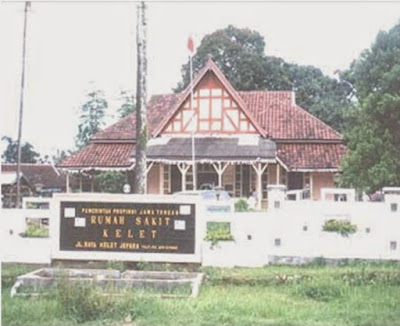These hospitals were subordinated by the district government. It was reported that total number of patient attendance were significantly decreased since severals years ago. Two of the district leprosy hospitals have changed the functions to a general hospital (Kelet, central Java and Sorong at Papua), Donorojo is not like a hospital, Alverno diversifies the function to cover non-leprosy patient only at OPD, some have already closed.
1. Kelet Hospital, 2003
Brief history of the hospital.
For the first time it was erected to cater for general diseases as a general hospital in 1915 owned by Zending during the Dutch occupation Indonesia. It was stated that the first director of the hospital was Dr H. Bervoets with his assistance Dr Durachim. Based on the government policy, the function the hospital was changed from general hospital to leprosy hospital in 1950. Since 1950 the hospital had not accepted general diseases anymore, because this hospital will be used for leprosy /ex-leprosy patients from the Plantungan and other places.
After some years the Zending handed over the hospital to the government.
Present situation
The hospital has a total of 150 beds, of which 130 provides for non-leprosy and 20 for leprosy patients. At present there is no more leprosy patients admitted to the hospital. The beds allocated to leprosy at present were empty. The hospital has area land of 25 hectares (compound and buildings). At present the Kelet leprosy hospital administratively is still directly under Tugurejo hospital of Semarang. The hospital does not perform surgery for leprosy patients. All leprosy patients undergoing operations are sent to Tugurejo hospital.
The staffs and the budget were set up in one package with Donorojo leprosy hospital & settlement. In very soon this hospital will become a district autonomic general hospital as the decree letter had been issued. Later on Donorojo hospital will be also separated from Kelet hospital.
2. Alverno leprosy hospital, 2003
Present situation
The hospital belongs to Keuskupan Agung Pontianak (Catholic church at Pontianak), situated about 3 kms from Singkawang the capital Kabupaten and 145 kms from Pontianak the capital of West Kalimantan province.
A –120 beds leprosy hospital was erected in 1925 caters for leprosy patients. Since last 3 years trend number of patients admitted decreased year by year. Total number of patients 134 (99), 54 (00), and 45 (01) or BOR is to be 112% (99), 45%(00) and 31% (01). Similarly trend of the clinical attendance at the OPD is significantly decreased from total of 1,895 in 1999 to 1,535 in 2001 or average 7 per day to 5 per day. At present the OPD is not only cater for leprosy but also for general disease. Dr H. Sumardi heads the hospital. There are 4 paramedics to run the OPD and In-patient departments. There is no physiotherapist but there is a trained paramedic to handle physiotherapy activities. The hospital can produce footwear and prosthesis for the need of leprosy patients.
According to hospital regulation after completion of necessary cares in the IPD, they should be discharged from the hospital. In reality, many patients did not want to go back as the family and community reject them. In such situation the hospital should find ways to solve the problems. Then the hospital with donors established 3 leprosy villages or settlements i.e Pakunam, Hok Lo Nam and
Roban settlements.
3. Sorong Leprosy Hospital (“Sele Be Solu”), 2003
Address: RS Sele Be Solu, KM 12, Jl. Basuki Rahmat, Sorong.
Brief history of Sorong Leprosy Hospital.
During that time the hospital issued regulations to protect surrounding people from infected by the disease as follows:
1. Leprosy patients in the hospital were not allowed to go out of the complex unless he or she has been declared cured.
2. The visitors entered the hospital must change their shoes with sandals provided by the hospital.
3. It is not allowed to give money directly to the patients. The money must be changed first with special coin made from iron.
The development of the hospital is as follows:
1. In 1963 Sele Be Solu hospital established as LeprosyRehabilitation Hospital, owned by Zending Nederland cooperated with Emmaus Swiss. Total number of leprosy patients were 198.
2. Since Irian Barat had been integrated to RI, then the owner of hospital was the provincial government of Irian Jaya province.
The name of the hospital was ProvincialLeprosy Rehabilitation Hospital. Operational budget derived from the provincial budget and Emmaus Swiss. Total number of patients were 230.
3. Base on the government policy the name of the hospital then changed to Sorong District Leprosy Hospital since 1987. This hospital was financed by Irian Jaya province. The donation from Emmaus Swiss then was allocated only for foot-wears and prosthetic purposes.
4. Following the autonomy regulation, the hospital belongs to the District of Sorong government since 1998.
5. At present (2003) the hospital has 50 beds (15 are provided for leprosy patients and 35 for general diseases). There are 11 leprosy patients hospitalized at present. The owner of the hospital was handed over from district government to the Sorong City government. Recently the Sorong City has changed the function of the hospital from leprosy hospital to General Hospital, but continue to cater for leprosy patients.
6. Operational cost for the hospital including for In-patients are provided by the local government.




